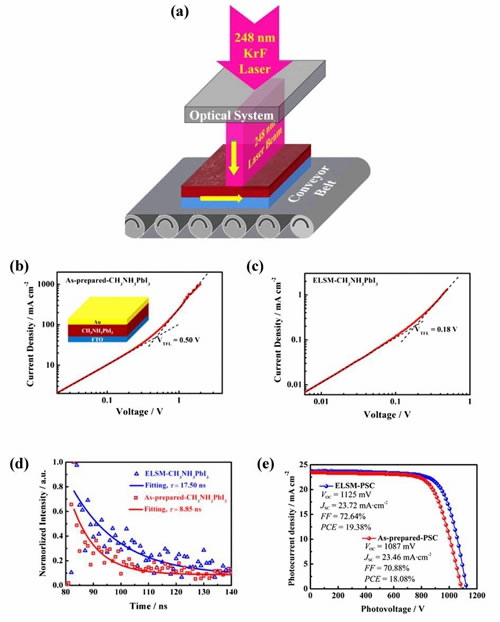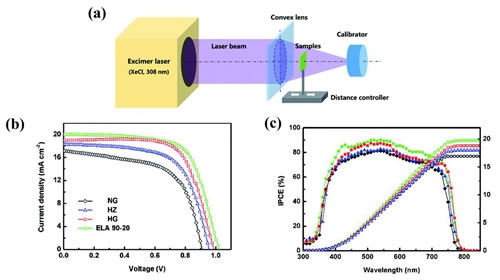The research team of Fang Xiaodong, a researcher of the Laser Technology Center of Anhui Institute of Optics and Fine Mechanics, Hefei Institute of Material Science, Chinese Academy of Sciences, has made new progress in using excimer laser technology to improve the performance of Perovskite solar cells (PSCs).
PSCs have developed rapidly since they were first reported in 2009. At present, their photoelectric conversion efficiency has surpassed polycrystalline silicon solar cells, reaching 24.2%, which has great application prospects. PSCs' light-absorbing layer organic-inorganic hybrid perovskite films are usually prepared by solution method at low temperature (<150 ℃), which can not only construct rigid solar cells but also have the natural advantage of developing flexible solar cells. However, there are a lot of defects on the surface of the perovskite thin film prepared by the solution method, which causes the recombination of photo-generated carriers and hinders the further improvement of battery performance. At the same time, the preparation process of the commonly used electron transport layer of PSCs needs to be annealed and crystallized at a temperature of 400 ~ 500 ℃, and this temperature exceeds the temperature that common flexible substrates can withstand, restricting the development of flexible PSCs.
In response to the above problems, combined with the characteristics of high excimer laser photon energy, large single pulse energy, short pulse time, large spot area, uniform energy distribution and small thermal effect, the research group introduced excimer laser technology into PSCs research. Excimer laser irradiation effectively reduces the concentration of surface defects in perovskite films, and realizes low temperature excimer laser annealing of the electron transport layer.
Associate researcher Wang Shimao and Ph.D. student Xueyan Yan of the research group used a 248nm (KrF) excimer laser to irradiate the CH3NH3PbI3 film to modify its surface. The defect concentration of the modified CH3NH3PbI3 film was reduced from 1.61 × 1016cm-3 to 5.81 × 1015cm-3. The transient fluorescence lifetime test showed that the non-radiative recombination of photo-generated carriers in the film was effectively suppressed under the light, and the photoelectric conversion efficiency of the battery It has also been significantly improved. Relevant research results were published in Solar RRL, a sub-journal of Advanced Materials, entitled "Rapid Surface Modification of CH3NH3PbI3 Thin Films Using a 248nm KrF Excimer Laser to Enhance the Performance of Perovskite Solar Cells".
The group's associate researcher Dong Weiwei and doctoral student Xia Rui et al. Applied excimer laser annealing (ELA) technology to the preparation of PSCs electron transport layer for the first time, using 308 nm (XeCl) excimer laser for magnetron sputtering The prepared gallium-doped zinc oxide (GZO) electron transport layer is annealed. After ELA treatment, the crystallinity, transmittance and conductivity of the GZO thin film, as well as the photoelectric conversion efficiency and stability of PSCs based on it have been significantly improved. Related achievements were published in RSC Advances under the title "Eximer Laser Annealing of Ga-doped ZnO Electron Transport Layer in Perovskite Solar Cells".
The above two research results are compatible with the existing low-temperature polysilicon annealing technology, and are expected to be applied to the production of commercial hard and flexible PSCs in the future.
The above research was supported by the National Natural Science Foundation of China, the Hundred Talents Program of the Chinese Academy of Sciences, the CAS-JSPS Joint Project, and the Chinese Academy of Sciences Key Laboratory of Photovoltaic and Energy-Saving Materials.

Figure 1 Schematic diagram of the optical path when the excimer laser treats the surface of the CH3NH3PbI3 film; (b, c) voltage and current curves based on the FTO / CH3NH3PbI3 (before and after excimer laser treatment) / Au structure, used to calculate CH3NH3PbI3 before and after excimer laser treatment Film defect concentration; (d) Transient fluorescence lifetime spectrum of CH3NH3PbI3 film before and after excimer laser treatment; (e) JV curve and battery performance of PSCs based on CH3NH3PbI3 film before and after excimer laser treatment.

Figure 2 (a) Schematic diagram of the optical path when the excimer laser anneals the GZO thin film; the (b) JV and (c) IPCE curves of the PSCs based on the excimer laser annealed GZO thin film and the PSCs based on other processing methods GZO.
Sewing Measuring Tape,Tailor Measuring Tape,Custom Logo Tape Measure,Tailor Measuring Soft Tape Measure
Shangqiu Hengli Measuring Tools Co.,Ltd , https://www.henglimtools.com
